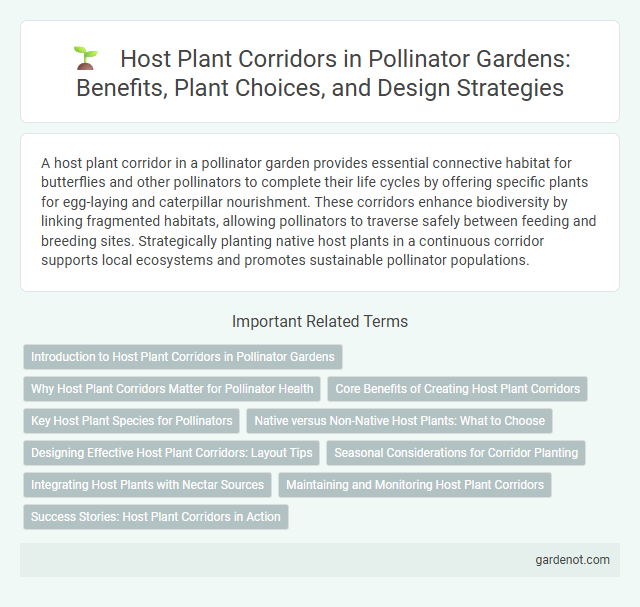A host plant corridor in a pollinator garden provides essential connective habitat for butterflies and other pollinators to complete their life cycles by offering specific plants for egg-laying and caterpillar nourishment. These corridors enhance biodiversity by linking fragmented habitats, allowing pollinators to traverse safely between feeding and breeding sites. Strategically planting native host plants in a continuous corridor supports local ecosystems and promotes sustainable pollinator populations.
Introduction to Host Plant Corridors in Pollinator Gardens
Host plant corridors serve as essential pathways within pollinator gardens, connecting isolated patches of native vegetation to support pollinator species' mobility and lifecycle needs. These corridors feature specific host plants that provide food and breeding sites for butterflies, bees, and other pollinating insects, enhancing biodiversity and ecosystem resilience. Establishing host plant corridors increases pollinator visitation rates and promotes genetic exchange among plant populations, vital for healthy garden ecosystems.
Why Host Plant Corridors Matter for Pollinator Health
Host plant corridors provide essential breeding and feeding habitats that support the life cycles of various pollinators, including bees, butterflies, and hummingbirds. These corridors enhance pollinator health by ensuring continuous access to diverse, native host plants necessary for larval development and adult nutrition. Establishing connected host plant corridors combats habitat fragmentation, promotes biodiversity, and strengthens ecosystem resilience.
Core Benefits of Creating Host Plant Corridors
Creating host plant corridors significantly enhances biodiversity by providing continuous habitats for pollinators, enabling safe migration and breeding opportunities. These corridors improve pollination efficiency for native plants and crops, supporting ecosystem health and food security. Host plant corridors also strengthen resilience against habitat fragmentation, promoting genetic diversity and long-term survival of pollinator populations.
Key Host Plant Species for Pollinators
Key host plant species for pollinators include milkweed, goldenrod, and native wildflowers such as coneflowers and bee balms, which provide essential nectar and pollen resources. These plants support diverse pollinator populations by offering continuous blooming periods and habitat connectivity within the host plant corridor. Incorporating a variety of native species ensures robust ecosystems, enhancing pollinator health and biodiversity.
Native versus Non-Native Host Plants: What to Choose
Choosing native host plants for a pollinator garden supports local ecosystems by providing essential habitats and food sources for indigenous pollinators. Non-native host plants may offer aesthetic variety but often lack the nutritional quality or compatibility needed by native pollinators, potentially disrupting natural pollination patterns. Prioritizing native species in a host plant corridor enhances biodiversity, resilience, and the overall ecological balance within your garden.
Designing Effective Host Plant Corridors: Layout Tips
Designing effective host plant corridors requires strategic selection and placement of native flowering plants that provide continuous nectar and pollen sources throughout pollinator active seasons. Incorporate diverse plant species spaced to facilitate easy movement for pollinators such as bees, butterflies, and hummingbirds, ensuring habitat connectivity across fragmented landscapes. Optimize corridor width and density to enhance microclimate stability and reduce exposure to predators, maximizing pollinator visitation and breeding success.
Seasonal Considerations for Corridor Planting
Host plant corridors require careful seasonal planning to ensure continuous food and habitat availability for pollinators throughout the year. Selecting native plant species that bloom sequentially across spring, summer, and fall supports diverse pollinator populations and promotes ecological resilience. Incorporating early-flowering trees, mid-season shrubs, and late-blooming wildflowers optimizes nectar and pollen sources vital for pollinator lifecycle stages.
Integrating Host Plants with Nectar Sources
Integrating host plants with nectar sources creates a vital corridor that supports the complete life cycle of pollinators such as butterflies and bees. By planting species like milkweed alongside nectar-rich flowers like coneflowers and bee balm, the garden provides essential food and breeding habitats, promoting biodiversity and pollinator health. This strategic combination enhances pollination efficiency and ecosystem resilience within the pollinator garden.
Maintaining and Monitoring Host Plant Corridors
Maintaining and monitoring host plant corridors is essential for supporting pollinator biodiversity and ensuring habitat connectivity. Regular inspections identify invasive species encroachment and plant health issues, enabling timely interventions to preserve native flora critical for pollinator lifecycles. Data collected from monitoring efforts inform adaptive management strategies, enhancing the corridor's ecological resilience and effectiveness.
Success Stories: Host Plant Corridors in Action
Host plant corridors have demonstrated remarkable success in restoring pollinator populations by providing continuous habitats that support native butterfly and bee species throughout their life cycles. For example, the Monarch Butterfly Corridor in the Midwest United States has boosted monarch migration and breeding by connecting fragmented milkweed patches over hundreds of miles. Wildlife ecologists report significant increases in pollinator diversity and abundance in areas where host plant corridors have been established, highlighting their effectiveness as conservation strategies.
Host plant corridor Infographic

 gardenot.com
gardenot.com